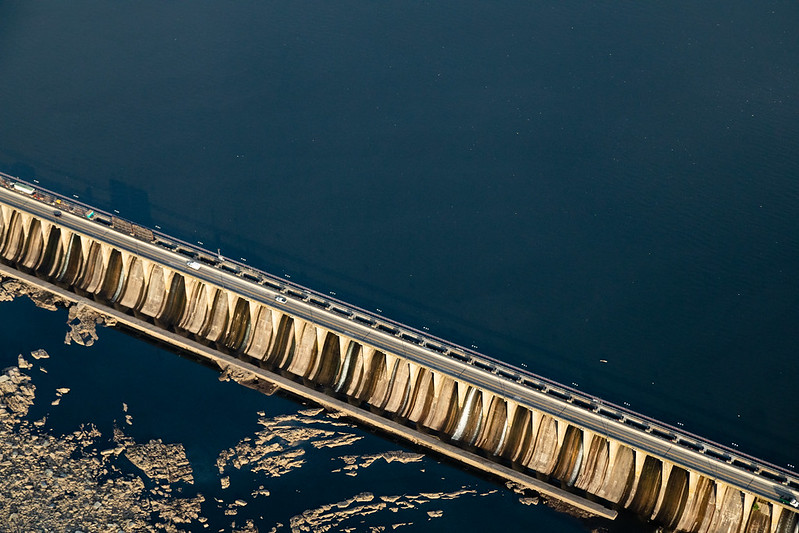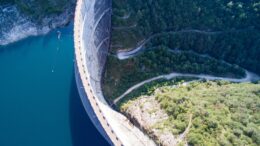Images of a shrinking Lake Mead illustrate a stark water crisis — one that’s being exacerbated by climate change. As the arid Southwest is getting hotter and drier, there’s less water to store.
But a lack of water isn’t the only kind of storage problem dams can present. They’re designed to hold back water — whether for water supply, hydropower or flood control — but they also block river sediment from flowing downstream. And over time it accumulates in reservoirs, leaving less and less space for water.
How bad is the problem? Pretty bad, it turns out. Some dams could lose up to 50% of their water-storage capacity by mid-century, according to a new study published in the journal Sustainability.
The study — conducted by researchers from the United Nations University Institute for Water, Environment and Health and other institutions — estimated the loss of storage from sedimentation in more than 47,000 large dams in 150 countries and called reservoir sedimentation “a significant challenge … that must be addressed.”
The Findings
The study isn’t the first to suggest that sedimentation is a problem — that’s been known for decades, although the researchers write that it’s also been largely ignored. Their work, however, is the first to assess potential storage loss on a global scale.
On average they found that by 2050 the world’s major dams will have lost more than a quarter of their storage capacity. Their findings varied by region and by country, with the size and age of dams being the biggest factors.
This is “an alert to this creeping global water challenge with potentially significant development implications,” they write.
The United States is expected to see the second-highest storage loss in the Americas after Panama, with 34% reduction expected across its 7,469 large dams by 2050. Europe, with thousands of old dams, has already lost 19% of its storage capacity, and that number will climb to 28% in the next 30 years.
In Africa, where dam construction is more recent, storage losses are predicted to be 17% by 2030 and 24% by 2050. The worst-hit will be the archipelago nation of Seychelles — which has two large dams around a half century in age. They are projected to lose half of their storage capacity by 2050.
Asia-Pacific, the most heavily dammed region in the world, should expect capacity losses around 23% by mid-century, lower than other regions. The biggest losses will be felt by Japan, where the average dam age is 100 years. The country has lost 39% of storage in its reservoirs already, and that will climb to 50% by 2050. After Japan, Azerbaijan (24%), Israel (24%), Kazakhstan (20%) and Afghanistan (20%) are next on the list.
“In Asia, the region where 60% of the world’s population lives, water storage is crucial in sustaining water and food security,” the researchers write. “It will face a more challenging future if it loses 23% of its water storage in large dams due to sedimentation.”
The Problem
One of the most significant problems from sedimentation, as the study points out, is the loss of storage capacity for water supply or flood control. As climate change brings longer droughts and bigger storms, maximizing water storage will become even more crucial.

But the loss of sediment that’s blocked by dams is also important downstream. Sediment flux in rivers provides the material for sandbars, dunes, marshes and barrier islands. These structures help protect communities from floods, storm surges and rising tides. And they also provide habitat and carry nutrients used by wildlife.
Sedimentation comes from riverbanks and upland runoff, but activities like deforestation, mining, and other development can cause it to increase.
And lately it has.
A study published in June 2022 in Science found that in the global hydrologic north, dams have blocked almost half the sediment that used to flow down rivers. But in the global hydrologic south, more intensive land use is causing greater erosion, leading to about 41% more suspended sediment in rivers there since the 1980s.
There are fewer dams there to block sediment, but that’s likely to change with 300 large dams planned for the Amazon — and more for other parts of South America and Oceania.
“The Amazon, which exports two-thirds of the sediment from South America and more sediment than any other global river, is home to globally unrivaled channel, floodplain, and estuary biodiversity and transfers essential nutrients to coastal waters,” the researchers wrote. “The planned dam projects there and on other unregulated rivers are particularly impactful because the current absence of dams allows virtually unchecked river transport of sediment, conditions that persist along few major rivers.”
The Solutions
How do we solve this engineered problem?
The researchers of the Sustainability study point to dredging but warn that it’s costly and temporary. A cheaper option is flushing out sediment, but that can have “significant adverse impacts downstream,” they caution. A better option would be a bypass that diverts flows around the dam using a separate channel.
There’s one other option. “Complete removal of dams, including those that are filled with sediments, is also a (slowly) emerging practice,” they write. “Dam removal can bring rivers back to their natural state and reestablish the natural river sediment transport.”
None of the solutions are easy, cheap or quick, which is why the researchers hope their study can ignite action.
“What’s important to underline is that the overall magnitude of water storage losses due to sedimentation is quite disturbing,” they write. “It adds to the list of water development issues that the world is already facing and has been unable to resolve.”
![]()
Get more from The Revelator. Subscribe to our newsletter, or follow us on Facebook and Twitter.


